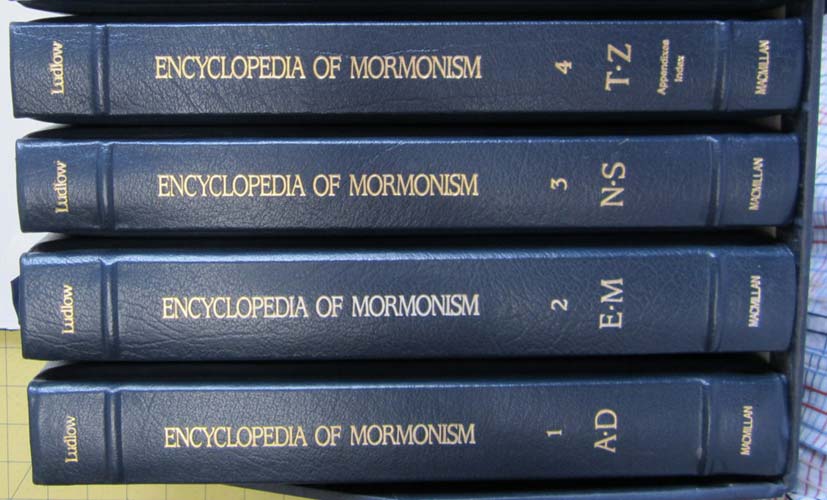What is Contained in Encyclopedia of Mormonism
The Encyclopedia of Mormonism is a semi-official English-language encyclopedia for topics relevant to The Church of Jesus Christ of Latter-day Saints. The five-volume texts have been digitized and are available for free online via the Harold B. Lee Library’s official website.
Encyclopedia of Mormonism Background:
Published in 1992, the Encyclopedia contains nearly 1500 articles, including several short unattributed entries in four volumes. The text is approximately one million words, and over 1,850 pages including pictures, maps, charts, indexes, and appendices. The title for the Encyclopedia of Mormonism was chosen by Macmillan, the secular publisher that initiated the project.
There were over 730 contributors from a wide variety of fields, most of whom had LDS and academic backgrounds. A large number were professors at Brigham Young University (BYU), the LDS Church-owned university. Most individuals contributed only one article, and few submitted more than three or four. Notable contributors include Mormon historians Leonard J. Arrington and Thomas G. Alexander, former Salt Lake City mayor Ted Wilson, noted non-Mormon LDS historian Jan Shipps, authors Steven R. Covey, Gerald N. Lund, and Richard Eyre, respected scholar and apologist Hugh Nibley, and a few members of LDS hierarchy such as H. David Burton and Jeffery R. Holland.
The editor of the Encyclopedia of Mormonism, Daniel H. Ludlow, states that he strove to make the volume as professional as possible. Most articles are written by Ph. D.s in their respective fields. LDS general authorities (the church’s spiritual leaders) wrote little of the Encyclopedia; indeed, most contributors from church hierarchy were only tapped to write articles on the publications or institutions they directly administered or led. For impartiality and perspective, several non-Mormons were asked to write important articles. For example, Shipps wrote on the outsider’s interpretation of Mormonism, and Richard P. Howard, a historian of the Reorganized Church of Jesus Christ of Latter-Day Saints (now the Community of Christ), wrote on his branch of the Latter Day Saint movement.
Subjects addressed:
The Encyclopedia of Mormonism includes lengthy articles on core LDS subjects like LDS Church history and doctrine, but the work also includes many topics that are less closely related to Mormonism. For example, articles on constitutional law, sports, science, and freedom discuss LDS perspectives and contributions to various fields.
Ludlow also sought to make the encyclopedia accessible to non-Mormons: an optional fifth volume was printed, containing the “Standard Works,” LDS scriptures that are heavily cited in the encyclopedia.
Role of encyclopedia relative to the LDS Church
Although the LDS Church cooperated in the production of the book, particularly by setting aside BYU resources, the Encyclopedia was meant to be independent and unofficial in the church. Ludlow highlights that in his concluding preface remarks:
Lest the role of the Encyclopedia be given more weight than it deserves, the editors make it clear that those who have written and edited have only tried to explain their understanding of Church history, doctrines, and procedures; their statement and opinions remain their own. The Encyclopedia of Mormonism is a joint product of Brigham Young University and Macmillan Publishing Company, and its contents do not necessarily represent the official position of The Church of Jesus Christ of Latter-day Saints. – Encyclopedia of Mormonism, p. lxii.
The LDS Church also noted the position in official publications.
Encyclopedia of Mormonism Views Of Contents:
In addition to established scholars like Nibley, many other LDS scholars who were then less known also contributed, including John Gee, William Hamblin, Louis C. Midgley, Daniel C. Peterson, Noel B. Reynolds, Stephen D. Ricks, John L. Sorenson, Melvin J. Thorne, and John W. Welch.
Critics had mixed reviews. Sterling M. McMurrin said that “the articles on social issues and church structure and the biographies are the most useful” but also felt that “the work is a carefully sanitized partisan affair that, while having many strengths, is quite uneven in quality and, though it appears to face many difficult issues head-on, clearly omits, distorts, and compromises wherever necessary to advance and protect a positive image of Mormons, Mormonism, and the church.” George D. Smith concluded his review of the Encyclopedia by saying, “As a ‘religious encyclopedia’ that addresses a goal of preserving a body of belief, the Encyclopedia of Mormonism impressively fulfills its mission. At the same time, the encyclopedia, like an iceberg, presents only a portion of important background and issues concerning the Book of Mormon. It is brief for orthodoxy that lacks the scope and diversity necessary to qualify it as truly encyclopedic.” The introduction to Sunstone’s review of the Encyclopedia mentioned that Lavina Fielding Anderson “pointed out ‘pitfalls in the treatment of women’s issues, but revealed a few surprisingly positive moments that otherwise might have been overlooked-and probably were by some editors.'”
No article on so-called Mormon historical revisionism is found in the Encyclopedia. It has been noted that after the Encyclopedia’s publication, several LDS scholars were excommunicated, including some members of the 1993 “September Six.” George D. Smith criticized the Encyclopedia because it is not the promised comprehensive treatment of Book of Mormon scholarship: “it is a statement of LDS orthodoxy.”
Summary About Mormonism:
Mormonism is the collective name for a group of related churches, movements, and theologies that trace their origins back to the prophetic revelations of Joseph Smith Jr. (b. 1805–d. 1844). The movement splintered following the death of Smith, with the Utah-based Church of Jesus Christ of Latter-day Saints (LDS) becoming by far the largest institutional manifestation of Mormonism today. Mormonism claims to be a restoration of ancient Christianity, following a period of apostasy after the death of Christ’s original apostles. The movement began with a series of revelations to Smith in the 1820s in which God called him to be a prophet and then an angel directed him to a buried ancient record written on golden plates. Smith translated this record “by the gift and power of God” and published it as the Book of Mormon, which is one of four books considered by Mormons to be scripture (along with the Christian Bible, the Doctrine, and Covenants, and Pearl of Great Price).
Mormons believe that God leads their church through living prophets and continuing revelation and that ordinances necessary for salvation and exaltation are performed only through the priesthood that was restored to Smith and passed on to the church today. Mormons prioritize family relationships, which they believe can be maintained after death through marriage ceremonies conducted in Mormon temples. Heavily persecuted in the 19th century for their practices of polygamy and theocracy, today Mormons are fully integrated into society even while maintaining a distinctive theology and group identity. The Church of Jesus Christ of Latter-day Saints operates an ambitious proselytizing campaign around the globe and continues to enjoy steady worldwide growth, with the majority of its members now residing outside the United States. Though strongly influenced by its origins in a modern American context, as it nears the beginning of its third century Mormonism is emerging as an increasingly mature global religion.
World Religions
Read also:
Mormon religion | Meaning, worship, holy book, rules &More
Recovery from Mormonism | 4 things and 12 Steps We want you to know?
Mormon marriage | Common questions about marriage in the LDS
Mormon missionaries | Common questions about Missionaries
Mormon beliefs | What are the core beliefs of Mormonism
Faith Cometh By Hearing | How to Increase Your Faith
Islam in Bhavishya Purana | Is It Really Predicted in Bhavishya Purana?




